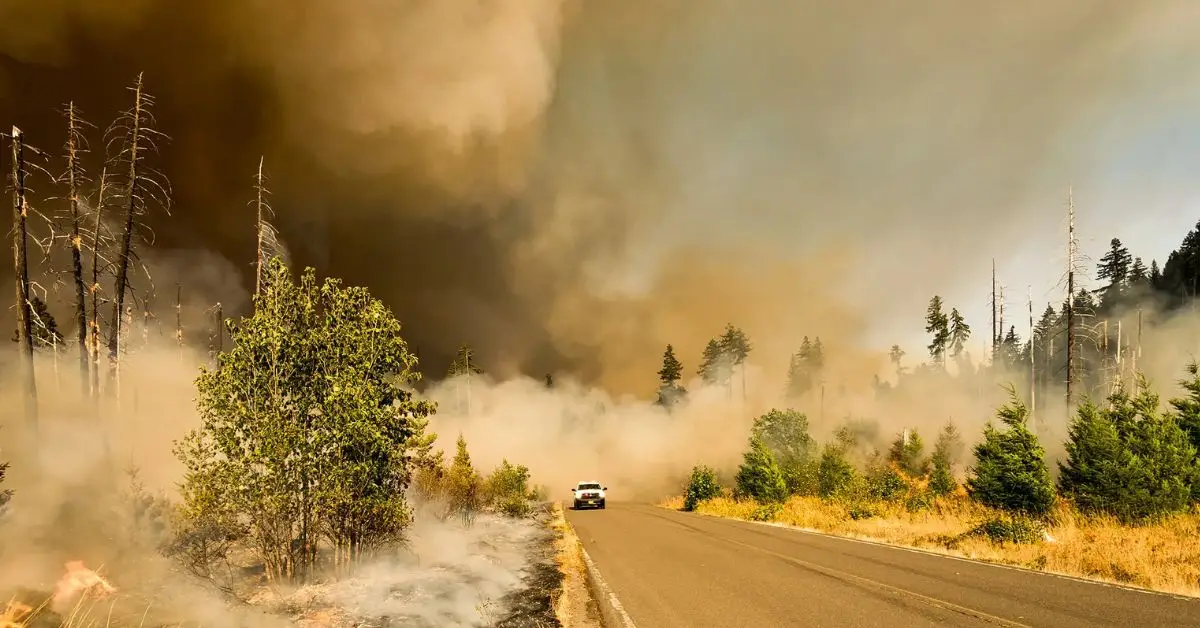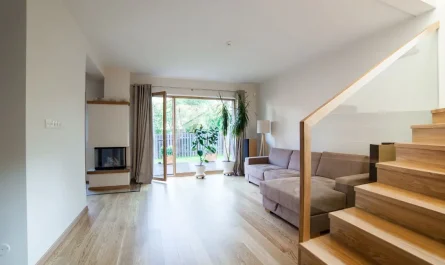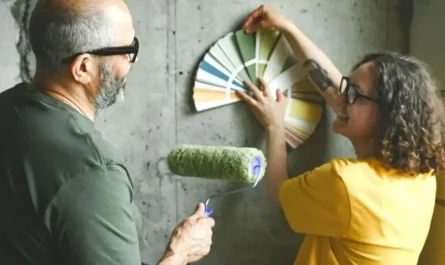How to Protect Your Home from Wildfire Smoke: 10 Must-Know Steps
You’re not dreaming if you’ve ever smelled smoke indoors during wildfire season, even with the windows closed. Smoke from wildfires doesn’t stay outside. While you sleep, it softly creeps in, becomes embedded in your furnishings, and remains in the air you breathe.
I used to believe that simply keeping the windows closed and the air conditioner running was sufficient. It was secure. However, I used a simple monitor to examine the air quality inside my house following a particularly severe wildfire last summer. Everything changed when I discovered it. In addition to being harmful, the inside air was almost the same as the outdoor air.
The majority of people believe their homes to be a secure barrier. They’re not. Wildfire smoke contains tiny particles. They enter through window frames, door gaps, dryer ducts, attic vents, and even exhausts in the kitchen or bathroom. To be impacted, you don’t have to live close to a fire. Smoke can spread over hundreds or even thousands of miles.
And discomfort isn’t the only issue here.Smoke from wildfires contains fine particulate matter (PM2.5), which can lead to major respiratory problems, cardiac problems, anxiety, and cognitive exhaustion. The danger is increased if you have older family members, small children, or someone with asthma living with you.
I’m going to walk you through ten doable, scientifically supported ways to truly keep wildfire smoke out of your home in this post. My own experience, expert interviews, and research into areas that most internet guides overlook have taught me these things.
Because your house should feel like a shield when the air outside becomes poisonous. It’s not a trap.
During wildfire season, have you ever checked the quality of the air indoors? What did you discover?
1. Understand the Threat: Why Smoke Even Reaches Indoors
Most individuals believe that the air inside must be fine if they are unable to smell smoke. Rarely is such the case.
Tiny, dangerous particles, particularly PM2.5, which is so small that it can pass through window frames, door gaps, attic vents, and even your HVAC system, make up wildfire smoke. An open window is not necessary. It enters through commonplace areas of your home that you most likely don’t consider.
Once inside, it stays there. Unless you actively remove them, PM2.5 particles can remain trapped in indoor air for hours or even days. Furthermore, the health implications are not limited to those who have allergies or asthma.
The most vulnerable groups include children, the elderly, and those with underlying medical issues, but this does not imply that everyone else is secure. You may simply have regular headaches, fatigue, or fogginess without understanding why.
You must realize this before we discuss filters or fans: your home is not built to block out wildfire smoke by default. That’s how you have to make it.
2. Track Air Quality: Use AQI Tools Proactively
When you smell wildfire smoke, that’s not the best time to safeguard your house. Before it enters, that is.
Tools for the Air Quality Index (AQI) keep you ahead of the game. You should check the AQI as often as you check the weather if you live in an area that is prone to wildfires or somewhere downwind. It’s time to act when the AQI rises beyond 100, particularly above 150. Close off your house, turn on air purifiers, and stay indoors.
You can establish real-time alerts using tools like AirNow.gov, PurpleAir, IQAir, or local air quality applications. When the AQI rises, some smart home appliances even start responding automatically.
Keep in mind that the harm has already started by the time the sky turns orange or your neck starts to itch. Like smoke alarms, smart homeowners view AQI notifications as time-saving early warnings.
3. Seal Your Home: Close, Block & Weather strip Openings
You may be surprised to learn how porous your house is.
Wildfire smoke can enter through gaps around door frames, attic hatches, dryer vents, and even recessed lights, even if your windows are closed. Because of this, one of the most important things to do during wildfire season is to seal the building envelope.
Start by weather-stripping the windows and doors on the outside. All ground-level doors should have door sweeps installed at the bottom. Fill up conspicuous cracks, particularly in attics or basements, with caulk or foam sealant. Make sure the damper is completely closed when not in use if you have a fireplace. In addition to protecting your windows from tornadoes, hurricane screens also provide an additional line of defense against smoke from wildfires getting inside through window holes.
Temporary fixes can also beneficial. On days with high levels of smoke, you can cover window-mounted air conditioners from the outside or tape over exhaust vents in the kitchen and bathroom. Learn about 10 Clever Ways to Get Your Windows Ready for Hurricane Season to increase the airtightness of your house and shield windows from storm damage and smoke.Several of these solutions also lessen smoke intrusion.
Your objective is to keep your house tightly sealed when it matters, not to make it airtight indefinitely.
4. HVAC Strategy: Recirculate Air & Upgrade Filters
During a smoke incident, your HVAC system can either protect or pollute.
Set it to recirculation mode as the first step. This prevents smokey external air from being drawn inside your home.
The second step is to improve your filter. Basic filters used in most households are unable to capture PM2.5 particles. Installing a MERV 13 or higher filter instead can capture up to 90% of the smoke particles from wildfires.
Use the maximum that your unit permits if your system is unable to handle MERV 13. Additionally, stay away from filters that just use electrostatic charge because they deteriorate more quickly when exposed to smoke.
During smoke days, leave the fan running constantly to continue filtering air in the background. Additionally, window sensors that notify you if a window or door is left open may be a good option for increased protection and surveillance during wildfire season. This will assist you keep your home sealed.
5. Create a Clean Air Room with a HEPA Air Cleaner
Create a safe area inside the house if you are unable to cleanse the entire space.
Select a space with few windows and doors, and use a HEPA air purifier constantly. This becomes your fallback during high-smoke days especially for kids, the elderly, or anyone with respiratory conditions.
When correctly set up, a clean room can limit smoke exposure by up to 80%.The US EPA
Avoid ozone air cleaners or ionizers. Stick totrue HEPAmodels. Or build your own with a box fan and MERV 13 filter (endorsed byAirNow).
Keep the door closed, filter running, and ventilation off. It makes a huge difference.
6. Avoid Indoor Sources of Pollution During Smoke Events
Don t worsen the air inside your home.During a smoke event, even simple actions like frying food or lighting a candle can make indoor air more toxic.
Skip vacuuming unless you have aHEPA vacuum. Don t use fireplaces, incense, or candles. Avoid heavy-duty cleaning chemicals or scented sprays.
Think of your home as a sealed zone. Everything you do inside either protects or pollutes.
7. Wear Proper Masks When Going Outside or Cleaning Ash
Even short trips outdoors can expose you to dangerous smoke particles. That s why aproperly fitted maskis non-negotiable during heavy smoke days.
Not just any mask works. A cloth or surgical mask won t block fine particles. What you need is anN95, N100, or KN95 respiratorthese are rated to filterPM2.5, the particle size that carries most of wildfire smoke s toxic load.
If you re doing cleanup after ash has settled say, on your patio or window sills go further.Wear goggles, gloves, a long-sleeved shirt, and a mask. Always mist ash lightly with water before sweeping or vacuuming (with a HEPA vacuum only).
8. Post-Smoke Cleanup: Freshen Indoor Air Safely
Even after the smoke clears outside,residue can linger indoorsin dust, on curtains, and in your HVAC system. Cleaning it wrong can reintroduce those particles into the air.
Start bygently wiping surfaceswith a damp microfiber cloth. Never dry-dust or use feather dusters they just push particles back into the air. For ash on floors,mist lightly and wet mop. Avoid vacuuming unless the machine is fitted with a HEPA filter.
Change HVAC filtersmonthlyafter a smoke event until the indoor air smells fresh again.
And if outdoor AQI improves (below 50), open windowsbrieflyto ventilate just enough to swap out stale indoor air without letting smoke back in.
9. Prepare Ahead: Stock Filters, Masks & Plan Evacuation Routes
Wildfire smoke isn t always predictable. What is predictable? The regret of not being prepared.
Before fire season begins,build your personal smoke-readiness kit. Include:
-
A
spare HEPA filter
for your portable air cleaner -
Extra
MERV 13 HVAC filters
-
Several
N95 or KN95 masks
per person - Batteries or power banks in case of outages
Also:know where clean-air sheltersare in your area, especially if your home lacks air filtration or if you care for at-risk people.
Make sure you havean evacuation planready, too. Fires move fast and smoke does, too.
Preparation improves outcomes. Stock filtration, have a plan, and know your clean-air shelter options.Ready.gov
10. Landscape & Home Retrofits to Reduce Future Smoke Impact
It s not just what s inside your home it s how your home is built and what surrounds it.
Certain design features and landscaping choices make homes more vulnerable to both fire and smoke. For example, wood shake roofs, open eaves, and dry vegetation all increase risk.
Instead, aim to create adefensible space: clear leaves from gutters, remove debris from around your house, andspace out shrubs or trees. Replace combustible mulch with stone or gravel near the foundation.
If you re planning renovations, consider installingmetal mesh vents,non-combustible roofing, ordual-pane windowsthat reduce both heat and smoke infiltration.
Homes with defensible space and ember-resistant features have a far higher survival rate.National Interagency Fire Center
Final Wrap-Up: Quick Safety Tips & When to Evacuate
If you ve read this far, you re taking the threat seriously and that s exactly what wildfire smoke demands. Here s a fast-reference checklist to help you stay ahead of it:
-
Keep windows and doors
shut and sealed
-
Monitor AQI
daily (alert set if AQI > 100) -
Use
MERV 13+ filters
or portable HEPA cleaners - Mask up (N95 or better) if stepping outside
-
Create a
clean air room
for high-risk household members - Avoid burning candles, incense, or using chemical sprays indoors
-
Change HVAC filters
monthly
post-smoke - Pre-stock air filters, extra masks, and water in advance
Even with the best prep, there are moments when staying put becomes unsafe:
-
Indoor air gets hot, humid, or smoky
despite filtration -
Anyone in the house develops
shortness of breath, chest tightness
, or dizziness -
AQI levels exceed 300
(Hazardous) for more than 12 hours -
Power goes out and you lose
access to air filtration or cooling
-
A local
evacuation notice
is issued even for smoke, not just flames
If that moment comes, don t hesitate. Grab your bag, your masks, your people and go.
Want more practical guides to protect your home and health?VisitBuild Like Newfor expert tips, checklists, and smarter living solutions.
Disclaimer:The information provided in this article is for educational and informational purposes only and does not constitute medical, environmental, or safety advice. Always consult with certified professionals, local health authorities, or emergency services when making decisions related to wildfire smoke exposure or evacuation. Build Like New is not responsible for any damages or actions taken based on this content.
Table of Contents
-
-
1. Understand the Threat: Why Smoke Even Reaches Indoors
-
2. Track Air Quality: Use AQI Tools Proactively
-
3. Seal Your Home: Close, Block & Weather strip Openings
-
4. HVAC Strategy: Recirculate Air & Upgrade Filters
-
5. Create a Clean Air Room with a HEPA Air Cleaner
-
6. Avoid Indoor Sources of Pollution During Smoke Events
-
7. Wear Proper Masks When Going Outside or Cleaning Ash
-
8. Post-Smoke Cleanup: Freshen Indoor Air Safely
-
9. Prepare Ahead: Stock Filters, Masks & Plan Evacuation Routes
-
10. Landscape & Home Retrofits to Reduce Future Smoke Impact
-
Quick Action Checklist
-
When It s Time to Evacuate
-
-
-
1. Understand the Threat: Why Smoke Even Reaches Indoors
-
2. Track Air Quality: Use AQI Tools Proactively
-
3. Seal Your Home: Close, Block & Weather strip Openings
-
4. HVAC Strategy: Recirculate Air & Upgrade Filters
-
5. Create a Clean Air Room with a HEPA Air Cleaner
-
6. Avoid Indoor Sources of Pollution During Smoke Events
-
7. Wear Proper Masks When Going Outside or Cleaning Ash
-
8. Post-Smoke Cleanup: Freshen Indoor Air Safely
-
9. Prepare Ahead: Stock Filters, Masks & Plan Evacuation Routes
-
10. Landscape & Home Retrofits to Reduce Future Smoke Impact
-
Quick Action Checklist
-
When It s Time to Evacuate
-
-
Quick Action Checklist
-
When It s Time to Evacuate




